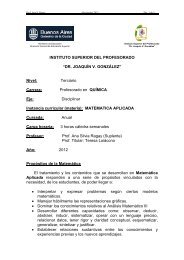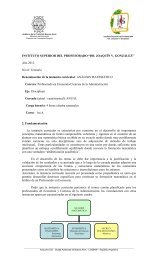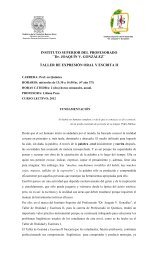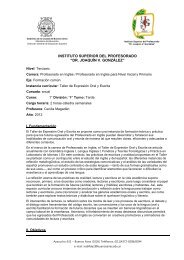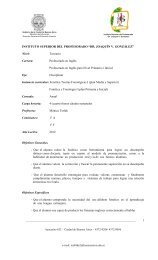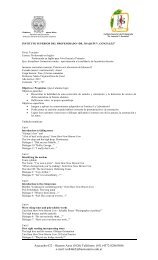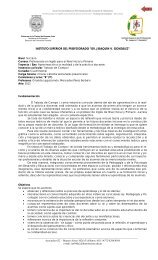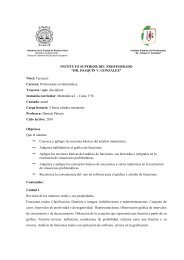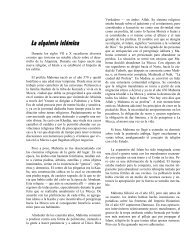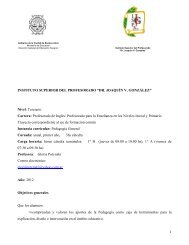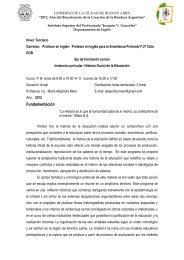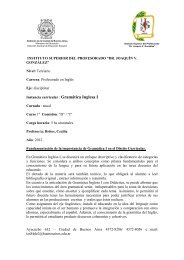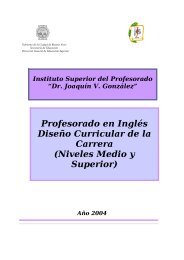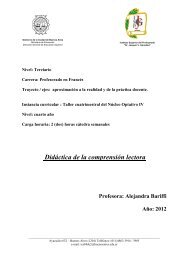Los retos de la historia oral en el siglo XXI: diversidades ...
Los retos de la historia oral en el siglo XXI: diversidades ...
Los retos de la historia oral en el siglo XXI: diversidades ...
You also want an ePaper? Increase the reach of your titles
YUMPU automatically turns print PDFs into web optimized ePapers that Google loves.
Sesiones parale<strong>la</strong>s / Parall<strong>el</strong> sessions<strong>la</strong>s Cajas <strong>de</strong> Crédito cooperativas, se transformó para sus dirig<strong>en</strong>tes <strong>en</strong> un mitoque cristalizó y organizó los acontecimi<strong>en</strong>tos históricos <strong>en</strong> un sistema <strong>de</strong> repres<strong>en</strong>tacionesque es narrado <strong>en</strong> términos sociales como una épica fundante.Ese mito ti<strong>en</strong>e tal peso <strong>en</strong> <strong>la</strong> conformación <strong>de</strong> una i<strong>de</strong>ntidad cooperativista,que se repite casi sin variantes aún <strong>en</strong> <strong>el</strong> recuerdo <strong>de</strong> qui<strong>en</strong>es no participaron<strong>de</strong> esas luchas por haber ingresado al movimi<strong>en</strong>to cooperativo posteriorm<strong>en</strong>te.En algunos testimonios, esa imposible concurr<strong>en</strong>cia no requiere <strong>de</strong> explicaciones:<strong>el</strong> “p<strong>el</strong>eamos” es sinónimo <strong>de</strong> “soy”, y cumple una función simbólica.En otros, <strong>la</strong> participación se produce tras<strong>la</strong>dando horizontalm<strong>en</strong>te ciertosacontecimi<strong>en</strong>tos sucedidos con posterioridad para conferirles una funciónperiodificadora que subraya su importancia. De una u otra manera, todos loscooperativistas “estuvieron ahí”, y <strong>de</strong>s<strong>de</strong> ahí se reconoc<strong>en</strong>.En ese contexto, <strong>el</strong> objeto <strong>de</strong>l trabajo es examinar los modos <strong>de</strong> operar <strong>de</strong> <strong>la</strong>memoria individual y colectiva <strong>en</strong> re<strong>la</strong>ción a <strong>la</strong> constitución <strong>de</strong> una i<strong>de</strong>ntidadinstitucional a partir <strong>de</strong>l análisis <strong>de</strong> 170 <strong>en</strong>trevistas a dirig<strong>en</strong>tes <strong>de</strong> <strong>en</strong>tida<strong>de</strong>scooperativas realizadas <strong>de</strong>s<strong>de</strong> 1996 <strong>en</strong> <strong>el</strong> proceso <strong>de</strong> creación <strong>de</strong>l Archivo Histórico<strong>de</strong>l Cooperativismo <strong>de</strong> Crédito. Las mismas correspon<strong>de</strong>n a <strong>la</strong> cohorteintegrada por qui<strong>en</strong>es ya estaban vincu<strong>la</strong>dos a una Caja <strong>de</strong> Créditos <strong>en</strong> 1966 ycontinuaron hasta -por lo m<strong>en</strong>os- 1979, fechas que se correspon<strong>de</strong>n con dosmom<strong>en</strong>tos significativos <strong>en</strong> <strong>el</strong> <strong>de</strong>sarrollo <strong>de</strong> <strong>la</strong>s <strong>en</strong>tida<strong>de</strong>s <strong>en</strong> cuestión.<strong>Los</strong> testimonios permit<strong>en</strong> <strong>en</strong>trever contradicciones <strong>en</strong>tre <strong>la</strong> valoración oficial<strong>de</strong> ciertos acontecimi<strong>en</strong>tos por parte <strong>de</strong> un movimi<strong>en</strong>to social y <strong>la</strong> percepción<strong>de</strong> sus dirig<strong>en</strong>tes, amplía <strong>el</strong> campo <strong>de</strong> análisis <strong>de</strong> esa organización y contribuyea <strong>la</strong> reflexión sobre los mecanismos <strong>de</strong> <strong>la</strong> memoria.The fight against the repressive measures and administrative regu<strong>la</strong>tions thatwas int<strong>en</strong><strong>de</strong>d to <strong>de</strong>stroy in the Arg<strong>en</strong>tina during the <strong>de</strong>ca<strong>de</strong>s of the ´60 and ´70to cooperative credit unions, became a myth that crystallized and organizedhistorical ev<strong>en</strong>ts in a system of repres<strong>en</strong>tations is narrated in social terms asan epic source for its lea<strong>de</strong>rs.That myth has such weight in the formation of a cooperative i<strong>de</strong>ntity, whichis repeated almost without variants still in the memory of those who did notparticipate of these struggles have joined the cooperative movem<strong>en</strong>t <strong>la</strong>ter. Insome accounts, that impossible concurr<strong>en</strong>cy does not require exp<strong>la</strong>nations:“fight” is synonymous with “I am”, and p<strong>la</strong>ys a symbolic role. In others, participationoccurs horizontally moving certain ev<strong>en</strong>ts subsequ<strong>en</strong>t to confer them afunction periodificadora which un<strong>de</strong>rlines its importance. In one way or another,all cooperators “were there”, and from there are recognized.In that context, the work aims to discuss ways to operate the individual andcollective memory in re<strong>la</strong>tion to the establishm<strong>en</strong>t of an institutional i<strong>de</strong>ntitybased on the analysis of 170 interviews with lea<strong>de</strong>rs of cooperative <strong>en</strong>titiesma<strong>de</strong> since 1996 in the process of creation of the historical file of the creditcooperative. These correspond to the integrated cohort who were alreadylinked to a box of credits in 1966 and continued until - at least - 1979, dateswhich correspond to two significant mom<strong>en</strong>ts in the <strong>de</strong>v<strong>el</strong>opm<strong>en</strong>t of the <strong>en</strong>titiesin question.Testimonies allow glimpse contradictions betwe<strong>en</strong> the official valuation ofcertain ev<strong>en</strong>ts from a social movem<strong>en</strong>t and the perception of their lea<strong>de</strong>rs, itext<strong>en</strong>ds the scope of analysis of that organization and contributes to the reflectionon the mechanisms of memory.VANEK, Miros<strong>la</strong>vThe Real Winners of the 1989 V<strong>el</strong>vet Revolution?Research of Economic Managem<strong>en</strong>t in Czechoslovakiain the Period of the So-Called “Normalization”and Transformation (1970–2011). An Oral HistoryProjectThe paper focuses on business and managem<strong>en</strong>t groups in ex-Czechoslovakiaand <strong>la</strong>ter Czech Republic, nam<strong>el</strong>y on managing and assistant directors of bigcompanies as w<strong>el</strong>l as medium and small <strong>en</strong>terprises. The project team hasconducted fifty interviews with these narrators-members of the economic<strong>el</strong>ite. Analyzed and interpreted results of these interviews repres<strong>en</strong>t a c<strong>en</strong>tralresearch question that the Czech and Czechoslovak historiography (as w<strong>el</strong>l ashistoriographies of other post-socialist countries) still hasn’t <strong>de</strong>alt with. Thatis also why the Oral History C<strong>en</strong>ter has un<strong>de</strong>rtak<strong>en</strong> this research task. Throughinterviews we learn not only about the s<strong>el</strong>ection process through which thesepeople were chos<strong>en</strong> for leading economic positions and to which ext<strong>en</strong>t it wasinflu<strong>en</strong>ced by the sophisticated system of the so called nom<strong>en</strong>k<strong>la</strong>tura (the keyadministrative positions in all spheres of the countries’ activity h<strong>el</strong>d only bythe Communist Party members, their “cadre profile” being unquestionable)but also how important was the actual knowledge of the profession. Surprisinglyfor some, many of these managers didn’t leave the leading positions afterthe country’s “new condition”. Some <strong>historia</strong>ns b<strong>el</strong>ieve that this is precis<strong>el</strong>y theproblem of our transformation period: that the economic <strong>en</strong>vironm<strong>en</strong>t in th<strong>en</strong>ew <strong>de</strong>mocracy (i.e. after 1989) has be<strong>en</strong> occupied and dominated by formercommunists who used their contacts from the past to privatize the Czechoslovakeconomy. But is it really so? Wasn’t it also because of the fact that ev<strong>en</strong>in authoritarian regimes many leading positions are occupied by real experts?A fact we may not like to accept but many interviews indicate. On the otherhand, there certainly was a consi<strong>de</strong>rable group of managers who gained theirpositions only because of the Communist Party membership and influ<strong>en</strong>tia<strong>la</strong>cquaintances. These were in<strong>de</strong>ed “political figures” rather than professionalsand inevitably had to leave after 1989. My paper should answer the questionwhether the economic <strong>el</strong>ite members have be<strong>en</strong> the main winners of the V<strong>el</strong>vetRevolution in Czechoslovakia in 1989.<strong>Los</strong> verda<strong>de</strong>ros ganadores <strong>de</strong> <strong>la</strong> Revolución <strong>de</strong> Terciop<strong>el</strong>o <strong>de</strong> 1989? Investigación<strong>de</strong> Gestión Económica <strong>en</strong> Checoslovaquia <strong>en</strong> <strong>el</strong> período <strong>de</strong> <strong>la</strong> así l<strong>la</strong>mada“normalización” y <strong>la</strong> Transformación (1970-2011). Un Proyecto <strong>de</strong> HistoriaOral.El docum<strong>en</strong>to se c<strong>en</strong>tra <strong>en</strong> los grupos empresariales y <strong>de</strong> gestión <strong>en</strong> <strong>la</strong> antiguaChecoslovaquia y más tar<strong>de</strong> <strong>la</strong> República Checa, es <strong>de</strong>cir, sobre <strong>la</strong>gestión y subdirectores <strong>de</strong> <strong>la</strong>s gran<strong>de</strong>s empresas así como <strong>la</strong>s empresasmedianas y pequeñas. El equipo <strong>de</strong>l proyecto ha llevado a cabo cincu<strong>en</strong>ta<strong>en</strong>trevistas con estos narradores son miembros <strong>de</strong> <strong>la</strong> élite económica.Analizar e interpretar los resultados <strong>de</strong> estas <strong>en</strong>trevistas constituy<strong>en</strong> unacuestión c<strong>en</strong>tral <strong>de</strong> <strong>la</strong> investigación que <strong>la</strong> historiografía checa y checoslovaca(así como otras historiografías <strong>de</strong> países post-socialistas) aún no se haocupado. Por eso también <strong>el</strong> C<strong>en</strong>tro <strong>de</strong> Historia Oral ha llevado a cabo estatarea <strong>de</strong> investigación. A través <strong>de</strong> <strong>en</strong>trevistas que apr<strong>en</strong><strong>de</strong>r no sólo sobre<strong>el</strong> proceso <strong>de</strong> s<strong>el</strong>ección a través <strong>de</strong>l cual estas personas fueron <strong>el</strong>egidaspara posiciones <strong>de</strong> li<strong>de</strong>razgo económico y <strong>en</strong> qué medida se vio influido por<strong>el</strong> sofisticado sistema <strong>de</strong> <strong>la</strong> nom<strong>en</strong>k<strong>la</strong>tura l<strong>la</strong>mado (<strong>la</strong>s posiciones administrativasc<strong>la</strong>ve <strong>en</strong> todas <strong>la</strong>s esferas <strong>de</strong> <strong>la</strong> actividad <strong>de</strong> los países <strong>de</strong> Accionistasc<strong>el</strong>ebrada sólo por los miembros <strong>de</strong>l Partido Comunista, su “perfil <strong>de</strong>cuadros”, si<strong>en</strong>do indiscutible), pero también lo importante que era <strong>el</strong> conocimi<strong>en</strong>toreal <strong>de</strong> <strong>la</strong> profesión. Sorpr<strong>en</strong><strong>de</strong>ntem<strong>en</strong>te para algunos, muchos<strong>de</strong> estos ger<strong>en</strong>tes no <strong>de</strong>jó <strong>la</strong>s primeras posiciones <strong>de</strong>spués <strong>de</strong> <strong>la</strong> “nuevacondición” <strong>de</strong>l país. Algunos <strong>historia</strong>dores cre<strong>en</strong> que este es precisam<strong>en</strong>te<strong>el</strong> problema <strong>de</strong> nuestro período <strong>de</strong> transformación: que <strong>el</strong> <strong>en</strong>torno económico<strong>en</strong> <strong>la</strong> nueva <strong>de</strong>mocracia (es <strong>de</strong>cir, <strong>de</strong>spués <strong>de</strong> 1989) ha sido ocupado ydominado por ex comunistas que utilizaron sus contactos <strong>de</strong>s<strong>de</strong> <strong>el</strong> pasadohasta <strong>la</strong> privatización <strong>de</strong> <strong>la</strong> economía checoslovaca. Pero es realm<strong>en</strong>te así?¿No fue también por <strong>el</strong> hecho <strong>de</strong> que incluso <strong>en</strong> los regím<strong>en</strong>es autoritariosmuchas posiciones <strong>de</strong> li<strong>de</strong>razgo están ocupados por verda<strong>de</strong>ros expertos?Un hecho que no le guste a aceptar, pero indican muchas <strong>en</strong>trevistas. Porotro <strong>la</strong>do, ciertam<strong>en</strong>te había un grupo consi<strong>de</strong>rable <strong>de</strong> los directivos queganaron sus posiciones sólo por <strong>el</strong> número <strong>de</strong> miembros <strong>de</strong>l Partido Comunistay amista<strong>de</strong>s influy<strong>en</strong>tes. Estos eran <strong>en</strong> realidad “figuras políticas” <strong>en</strong>lugar <strong>de</strong> profesionales e, inevitablem<strong>en</strong>te, tuvo que abandonar <strong>de</strong>spués <strong>de</strong>1989. Mi pap<strong>el</strong> <strong>de</strong>be respon<strong>de</strong>r a <strong>la</strong> cuestión <strong>de</strong> si los miembros <strong>de</strong> <strong>la</strong> éliteeconómica han sido los principales ganadores <strong>de</strong> <strong>la</strong> Revolución <strong>de</strong> Terciop<strong>el</strong>o<strong>en</strong> Checoslovaquia <strong>en</strong> 1989.FAY, C<strong>la</strong>udia Musa y OLIVEIRA, G<strong>en</strong>eci Guimaraes <strong>de</strong>A crise da Varig através do olhar <strong>de</strong> seus trabalhadoresVarig, the first commercial airline in Brazil, boasts a number that establishedit as one of the world market´s lea<strong>de</strong>r. Over more than 78 years of exist<strong>en</strong>ce,Varig transported thousands of pass<strong>en</strong>gers and had on its chart nearly 25.000employees. Their airp<strong>la</strong>nes were used on every contin<strong>en</strong>t. This communicationis based on research conducted by the C<strong>en</strong>ter for Oral History- PUCRS,with emphasis on Business History and it aims to bring to the discussion th<strong>el</strong>ook of these employees in connection with the company that w<strong>el</strong>comed them,making them part of the huge “variguiana family” in such a way that they f<strong>el</strong>t as<strong>en</strong>se of loss wh<strong>en</strong> the company closed its doors.Oral History methodology will be used to analyze the symbolic aspectsconstructed by individuals involved in the process, especially those whop<strong>la</strong>yed their roles in an airp<strong>la</strong>ne, in or<strong>de</strong>r to preserve the memory of thisgroup that b<strong>el</strong>onged to Varig, in an attempt to un<strong>de</strong>rstand the human universeof this company, truly nacional. Alessandro Port<strong>el</strong>li reinforces theimportance of <strong>oral</strong> sources, in particu<strong>la</strong>r “the History of Memory, Historyof Imagination, History of Subjectivity (both individuals and institutions)”.Through the investigation obtained from life histories, it can also be ma<strong>de</strong>infer<strong>en</strong>ces about issues that involved the re<strong>la</strong>tions betwe<strong>en</strong> work-family,work-company, work-i<strong>de</strong>ntity and a s<strong>en</strong>se of b<strong>el</strong>onging that i<strong>de</strong>ntified theemployee with Varig.44



